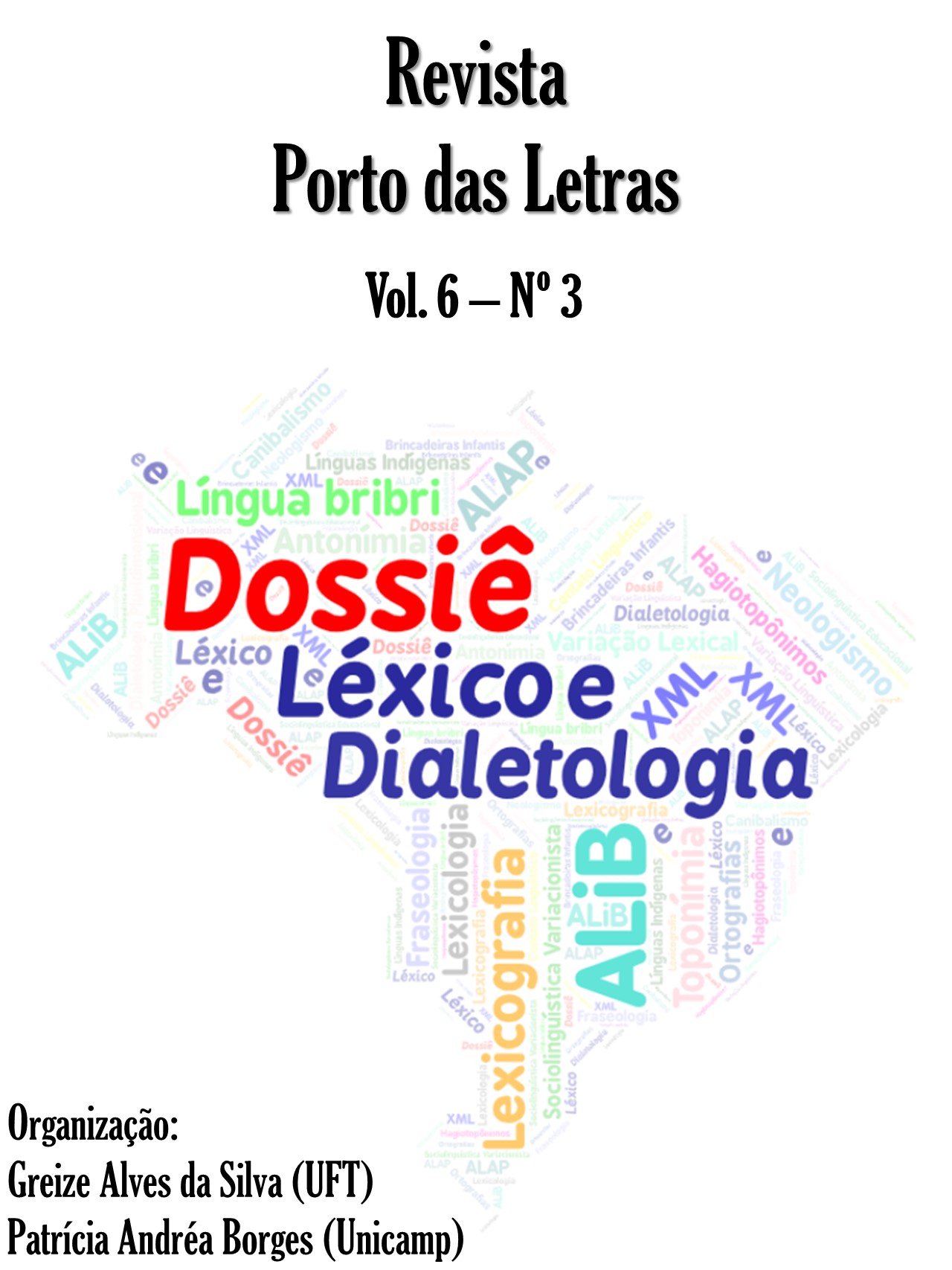CANJICA OU CURAU COM COCO: DESCREVENDO A NORMA LEXICAL DO PORTUGUÊS BRASILEIRO A PARTIR DOS DADOS DO ALIB
Keywords:
Dialetologia; Projeto ALiB; variação lexical; regionalismos; canjica/curau com coco.Abstract
This article, guided by theoretical principles of Pluridimensional Geolinguistics (THUN, 2000), aims to discuss the pattern of general and regionals norm, from description and analyse of lexicals variants diatopic distribution registered as answers to the question 179, to verify variants for canjica/ curau with coconut, applied by Linguistic Atlas of Brazil Project (ALiB) members, to 250 localities situated on Brazilian territory. It was cropped a sample containing 1000 informants with Primary education, residents in the national capitals and countryside of the total established by the project, considering the diassexual variable (men and women) and diageracional variable (young and old person). Throught the elaboration of linguistic maps, photographing the national and the regional distribution, it was found the formation of area that could be delimited by isolexicons, indicating the regional variants integration. Further, to validate the linguistic forms registered, we consulted general and etymological dictionaries. In summary, we have gotten some regionalisms, however, to this referring, we haven’t observed the configuration of a designation with general use in Brazil; in addiction, the diversity nominations revealed the influx of regional customs in the denomination process, such as the habit of adding or not specific ingredients as the coconut in the original cooking recipe, attesting the relevance of considering the cultural and economic specificity of each location in the investigation about these linguistic forms vitality.
References
AULETE, Caldas. Aulete digital: Dicionário contemporâneo da língua portuguesa: Dicionário Caldas Aulete, versão online. Disponível em: http://www.aulete.com.br/site.php?mdl=aulete_digital. Acesso em: 23 jun. 2020.
BIDERMAN, Maria Tereza C. Teoria lingüística: lingüística quantitativa e computacional. Rio de Janeiro: Livros Técnicos e Científicos, 1978.
CARDOSO, Suzana Alice M. et al. Atlas linguístico do Brasil. Introdução. v. 1. Londrina: EDUEL, 2014a.
CARDOSO, Suzana Alice M. et al. Atlas linguístico do Brasil. Cartas Linguísticas. v. 2. Londrina: EDUEL, 2014b.
CARDOSO, Suzana Alice M. Geolinguística: tradição e modernidade. São Paulo: Parábola Editorial, 2010.
COMITÊ NACIONAL DO PROJETO ATLAS LINGUÍSTICO DO BRASIL. Questionários. Londrina: EDUEL, 2001.
COSERIU, Eugenio. Sistema, norma e fala. In: COSERIU, E. Teoria da linguagem e linguística geral. Rio de Janeiro: Presença, 1979.
CUNHA, Antônio G. da. Dicionário etimológico da língua portuguesa. 4. ed. Rio de Janeiro: Lexikon, 2010.
DIÉGUES JUNIOR Manuel. Regiões culturais do Brasil. Rio de Janeiro: Instituto Nacional de Estudos Pedagógicos (INEP), 1960.
FARACO, Carlos Alberto; ZILLES, Ana Maria. Para conhecer norma linguística. São Paulo: Contexto, 2017.
FERREIRA, Aurélio Buarque de Holanda. Dicionário Aurélio da língua portuguesa. 5. ed. Curitiba: Positivo, 2010.
HOUAISS, Antonio; VILLAR, Mauro de Salles. Dicionário Houaiss da Língua Portuguesa. Rio de Janeiro: Objetiva, 2009.
ISQUERDO, A. N. Herança lusa na toponímia de municípios da região Norte do Brasil: perspectivas linguística e sócio-histórica. In: XXVIIE CONGRÈS INTERNATIONAL DE LINGUISTIQUE ET DE PHILOLOGIE ROMANES. Section 5: Lexicologie, phraséologie, lexicographie, v.5, 2016, Nancy. Actes [...]. Nancy: ATILF, 2016. p. 315-328.
ISQUERDO, Aparecida N. A propósito de dicionários de regionalismos do português do Brasil. In: ISQUERDO, Aparecida N; ALVES, Ieda M. (org.). As ciências do léxico: lexicologia, lexicografia, terminologia. v. II. Campo Grande: UFMS, São Paulo: Humanitas, 2007.
ISQUERDO, Aparecida N. Achegas para a discussão do conceito de regionalismos no português do Brasil. Alfa, São Paulo, 50 (2), p. 9-24, 2006. Disponível em: http://seer.fclar.unesp.br/alfa/article/view/1408. Acesso em: 29 jun. 2020.
MOTA, Jacyra A. Reflexões sobre a arte de fazer inquéritos lingüísticos. In: MOTA, J. A; CARDOSO, S. A. M. (org.). Documentos 2: Projeto Atlas Linguístico do Brasil. Salvador: Quarteto, 2006. p. 239-259.
MOTA, Jacyra A.; CARDOSO, S. A. M. A construção de um Atlas Linguístico do Brasil: o percurso do ALiB. Signum: Estudos da Linguagem, Londrina, v. 12, n. 1, p. 237-256, jul. 2009.
OLIVEIRA, Ana Maria Pinto Pires de. O português do Brasil: brasileirismos e regionalismos. 1999. Tese (Doutorado em Linguística e Língua Portuguesa) – Faculdade de Ciências e Letras, Universidade Estadual Paulista, Araraquara, 1999.
PONTES, Antonio L. Dicionário para uso escolar: o que é, como se lê. Fortaleza: EdUECE, 2009.
ROMANO, Valter P.; SEABRA, Rodrigo D.; OLIVEIRA, Nathan. [SGVCLin] - Software para geração e visualização de cartas linguísticas. RELin: Revista de Estudos da Linguagem, v. 22, n. 1, p. 119-151, jan./jun. 2014.
ROMANO, Valter Pereira. Em busca de falares a partir de áreas lexicais no Centro-Sul do Brasil. 2015. 2v. Tese (Doutorado em Estudos da Linguagem) – Universidade Estadual de Londrina, Londrina, 2015.
SAPIR, E. Língua e ambiente. In: SAPIR, E. Linguística como ciência. Tradução de Joaquim Mattoso Camara Junior. Rio de Janeiro: Acadêmica, 1969. p. 43-62.
THUN, Harald. La géographie linguistique romane à la fin du XXe. Siècle. CONGRÈS INTERNATIONAL DE LINGUISTIQUE ET DE PHILOLOGIE ROMANES. 1998, Bruxelas. Actes [...] v. 3. Vivacité et diversité de la variation linguistique. Tübingen: Niemeyer, 2000, p. 367-388.
XXX. 2019. 2 v. Tese (Doutorado em Estudos da Linguagem) - Universidade Estadual de Londrina, Londrina, 2019.
YIDA, Vanessa; GHOLMIE, Myriam R. S.; VASCONCELOS, Celciane A. Estratégias para a obtenção de respostas nos inquéritos do ALiB: a questão 054 (aftosa) nas capitais do Centro-Oeste e Sudeste. Signum: Estudos da Linguagem, v. 21, n. 1, p. 32-54, abr. 2018.
Downloads
Published
How to Cite
Issue
Section
License
Os autores concordam com os termos da Declaração de Direito Autoral, que se aplicará a esta submissão caso seja publicada nesta revista (comentários ao editor podem ser incluídos a seguir).

